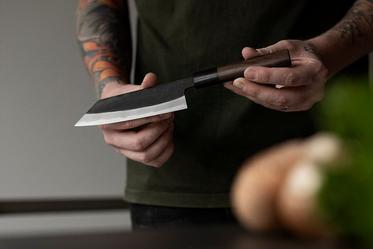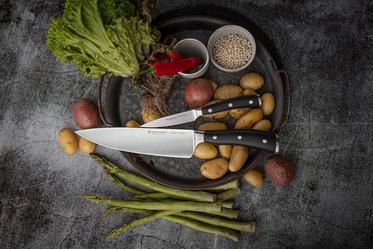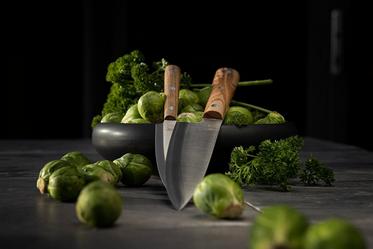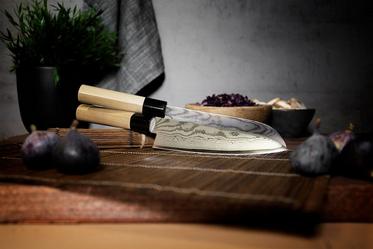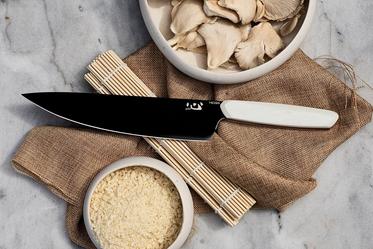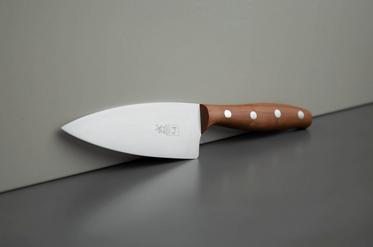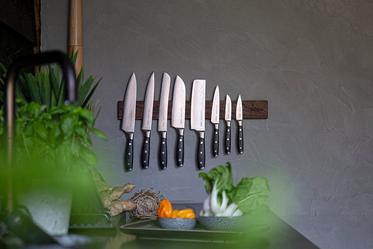Steel types for kitchen knives
When you purchase a knife we recommend getting familiar with the types of steel available and choosing one that suits the expectations you have for a knife. We made an overview of the most common types of steel used for kitchen knives.
Aogami / Blue Paper Steel
Taken literally, Aogami means 'blue paper' in Japanese. It owes its name to the packaging in which the manufacturer Hitachi delivers the steel. It is a version of White Paper Steel; a very pure type of steel taken from iron-rich river sand with only carbon as an alloy. White Paper Steel is similar to the traditional Tamahagene steel that was/is used to create Japanese swords.
Blue Paper Steel is White Paper Steel with the addition of small amounts of chrome and tungsten. It might make the steel a little less traditional but it does improve the qualities. Blue Paper Steel is more resistant to corrosion and chipping than White Paper Steel, although it is certainly not a stainless type of steel.
There are three gradations of Blue Paper steel: #2, #1 and Super. For the Eden Kanso Aogami knives the 'number 2' is used with 1.2% carbon. This leaves you with a hard (62-63 HRC) knife that can be sharpened razor-sharp but is also rock-solid.
Check out all Aogami steel kitchen knives here
AUS-10
AUS-10 steel is made in the Japanese city of Tokai, by Aichi Steel. It is a stainless steel because chromium, molybdenum and vanadium were added to it. As such the steel is stainless and wear and tear resistant. With a hardness of 60 HRC it is a rock-solid type of stainless steel with a high carbon-content of approx. 1.05. It, however, won't easily break thanks to the addition of elements such as nickel, manganese and silicon. In comparison to other hard types of steel you can easily sharpen AUS-10.
Check out all AUS-10 steel kitchen knives here
X50CrMoV15
X50CrMoV15 is the most used type of stainless steel for kitchen knives by, amongst others, German manufacturers. It is a good type of steel for a very large audience. The corrosion resistance is very good and the cutting qualities are great.
Great for family use and professional use where not everyone handles the knives with the same care. FYI: X stands for stainless, 50 for 0.50% carbon and 15 for 15% chromium. This addition of chromium makes the steel stainless. In addition, the steel contains small amounts of Molybdenum(Mo) and Vanadium(V) to improve the grain structure and the wear resistance.
1.4116
1.4116 is a stainless type of steel with a high carbon content. This type of steel is, amongst others, used for the famous Swiss pocket knives and is, in terms of qualities, almost identical to x50crmov15 steel. Excellent corrosion resistance, it retains its sharpness for a long time and is easy to sharpen.
Check out all kitchen knives with 1.4116 steel
VG10
VG10 is a stainless type of steel with a high carbon percentage. For a stainless type of steel at least. VG10 contains 1% of carbon. As such, VG10 is harder than most stainless types of steel. The cutting qualities are very good and it is easy to sharpen.
The corrosion resistance is, overall, good, VG10 steel, however, is more sensitive to pit corrosion than types of steel with a lower carbon content. The moment you find a speck of rust you need to polish/grind it, to prevent the corrosion from spreading. Regularly sharpening the edge prevents corrosion which can lead to chipping. Never put VG10 steel knives in the dishwasher and never leave them to soak in the sink. Softer types of steel are a little more forgiving in this respect.
VG10 steel is almost always laminated in between two layers of softer and more corrosion resistant steel. This increases the corrosion resistance and simplifies the production process. Sometimes layers of only stainless steel are used which results into a 3-layer blade and sometimes 16 or 32-layer damascus is used, which results into a 33 or 65-layer blade. The manufacturer of VG10 steel is Hitachi, but often the name of the factory Takefu is used, which markets the steel already laminated.
Another name for VG10 steel is 'V-Gold 10'. Sometimes the name 'Cobalt Steel' is used as well, but that could also refer to another type of steel that contains Cobalt. In addition to VG10, you also have VG-MAX. VG MAX IS optimized further with a higher chromium and vanadium content.
Check out all VG10 steel kitchen knives
Cromova 18
Cromova is the name Global uses for the stainless steel they use. The steel is comprised of 0.8% carbon and the addition of chromium, molybdenum and vanadium. Cromova steel has a fine grain structure and can be sharpened razor-sharp. It combines good cutting qualities with corrosion resistance.
Friodur
Friodur steel is a stainless type of steel that is mostly used by J.A. Henckels. Known from the Zwilling kitchen knives. The remarkable aspect of this type of steel is the heat treatment the steel is subjected to. First the steel is heated up after which it is cooled down. This is how basically every knife is hardened. With Friodur steel, however, the whole is cooled down to -70°C degrees. As such the knife is even harder and more corrosion resistant.
Check out all kitchen knives with Friodur steel
440A and 440C
440 steel is a stainless type of steel that retains its sharpness well and is also corrosion resistant. For 440A steel the emphasis is placed on the corrosion resistance. While 440C, in comparison, focuses on hardness. With the right heat treatment it is possible to turn 440C into the hardest, strongest and most wear and tear resistant type of steel ever produced.
440C and 440A are basically the same types of steel. The difference is the carbon percentage. 440A has a carbon percentage between 0.60% and 0.75%. 440C has a higher carbon content between 0.95% and 1.2%.
Sandvik 12C27 and 14C28N
Sandvik is a producer of different stainless types of steel. The most famous type of steel is 12C27. This type of steel is used for the popular Morakniv knives, but also Opinel and Laguiole and Aubrac have been using this type of steel for years. All because this type of steel is easy to modify and it retains its sharpness well. It is not the hardest type of steel around, also making it easier to sharpen.
Sandvik 14C28N steel can be compared to 12C27 steel, but contains additional nitrogen and slightly more carbon. As such the knife is a little more tough and wear and tear resistant. In reality you hardly notice this difference.
Carbon steel in general
Carbon steel is a type of steel with a carbon content of at least 0.05% up to 2.1% carbon. We, however, often see that manufacturers call everything that is not stainless steel, carbon steel. Carbon is the element that gives the knife its hardness. All other additions ensure that the steel is more corrosion resistant or tougher, but this is at the expense of the hardness. And, the harder the knife, the thinner you can sharpen it, the sharper the knife will become. This hardness, however, is often accompanied by a susceptibility to rust and high brittleness. Truly good carbon steel is therefore a perfect balance between a high carbon content and minimal additions such as cobalt, molybdenum or vanadium.
Check out all kitchen knives with carbon steel
Stainless steel in general
Stainless steel, also called corrosion resistant steel, is a collective name for all types of steel that are comprised of up to 1.2% carbon and at least 11% chromium. Because of the addition of chromium the chances of rust are reduced. As mentioned before the addition of chromium does affect the hardness of the steel. To make sure this type of steel can still be used on knives, elements such as vanadium, molybdenum, titanium, nitrogen or silicon are added. As such the steel is harder and more wear and tear resistant.
A carbon steel kitchen knife and the maintenance included is not for everyone. That is why choosing stainless steel is not a bad choice. Today there are types of stainless steel that are harder and more wear and tear resistant than certain types of carbon steel. Stainless steel kitchen knives are easier to maintain, but they can rust. Read more about why stainless steel can rust here.
Check out all stainless steel kitchen knives here
Damascus steel
Damascus steel is not really a type of steel, but it has grown in popularity and it is used for kitchen knives more and more often. Damascus steel is often comprised of two types of different steel with a different carbon percentage. These two types of steel are alternately forged together. After forging the blade, it is etched. Steel with a high carbon content will then turn dark. The steel with a low carbon percentage stays light in terms of colour. You are left with a nice contrast, clearly seeing all layers. Read more about damascus steel here.
Check out all damascus steel knives here
Other materials
For years many have been trying to create the ultimate knife that does not have to be sharpened at all. In reality it is not that easy. We haven't come across knives that live up to this promise. The same, for instance, also applies to ceramic knives.
